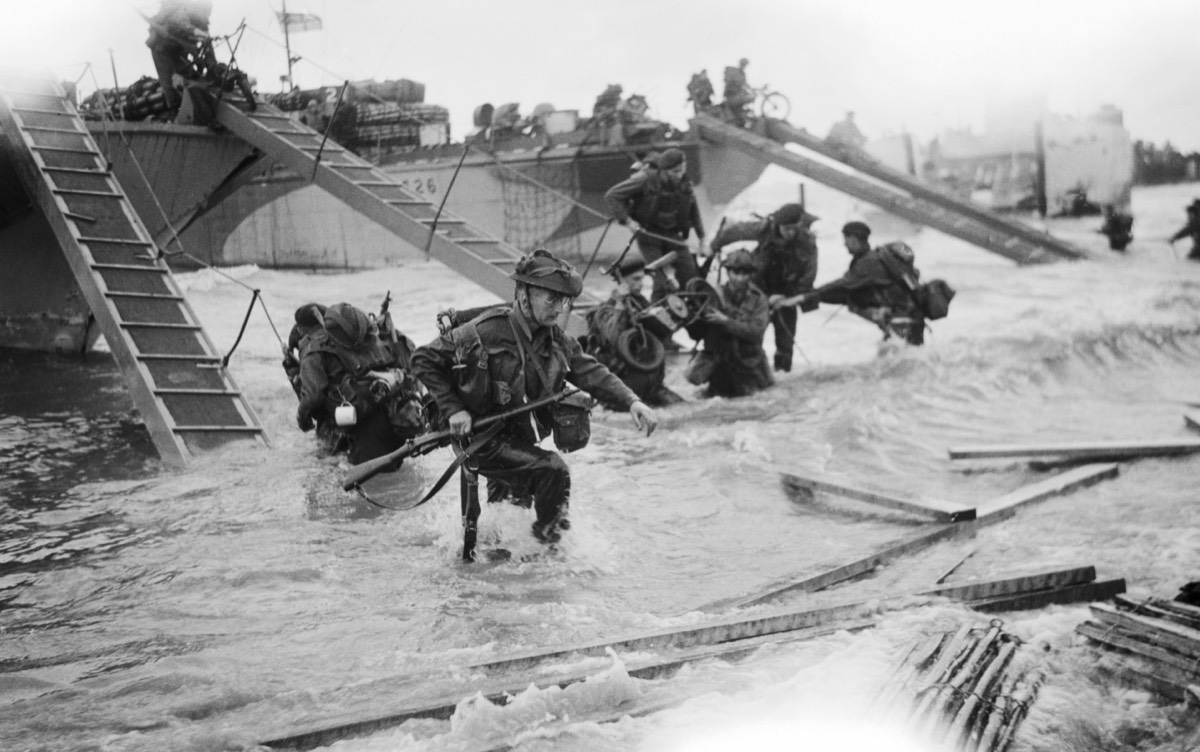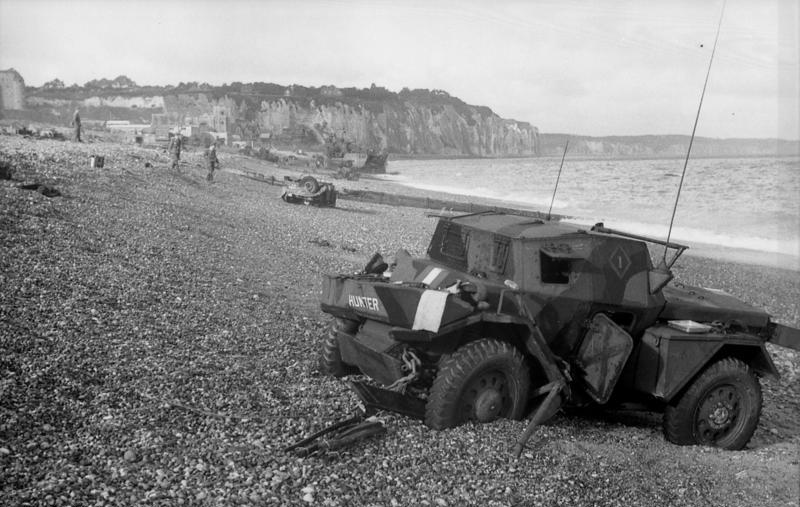D-Day Rehearsals

The real thing: British troops landing at St Aubin sur Mer on D-Day.
Exclusion Zone
In the Spring of 1944 East Lothian’s coastline was placed out of bounds for anyone other than residents and all those who possessed the correct pass. This was a means of keeping unwelcome eyes far away from anything going on on East Lothian’s beaches. The zone ran from the west of Prestonpans along the old A1, north of Tranent, along the old A1 again past Macmerry airfield, past Haddington and north of East Linton to end near Dunbar at Tyninghame.
Anyone found trying to enter the zone without the correct pass was denied entry. However, there is at least one case of someone who entered the zone without the correct pass and did so a number of times. Tadeusz Brylak, stationed in Gosford with the Polish 1st Motorised Artillery Regiment, recounts how he evaded the authorities:
“My wife-to-be, who was in the ATS living in Edinburgh, had to get a pass when she wanted to come to visit her mother inside the zone. I managed to bluff my way into the zone a number of times when I came with my wife on a bus going into the zone. The military police would come on the bus and check everyone’s papers and they would ask me where I was going. I knew very little about North Berwick but I said I was staying at a hotel there which had been taken over by the military. I did this a number of times.”
[Source: Interview, 17th June 2013]
The Lessons Of Dieppe

Abandoned equipment on the beach at Dieppe.
Gullane: The Same As Normandy?
Having learnt lessons the hard way, considerable efforts were made prior to D-Day to survey the composition of the surface and sub-surface sands of the intended landing beaches in Normandy, a task which, on occasions, involved X Craft. At night Naval frogmen were taken close to the beaches where they could take soil samples, later analysed back in Britain. It wasn’t long before geologists spotted that the physical geography of Gullane beach was remarkably similar to that of the landing beach at Asnelles, east of Arromanches in Normandy. Gullane beach was therefore chosen as suitable ground for training the Navy and the Army in the complicated processes of a sea-borne landing.

Gullane beach from the village above.
Gullane Landings: Personal Experiences
Exercises in beach landings began at Gullane in early 1944. First of all the necessary military equipment was loaded onto ships in Leith, sailed to lie offshore by Gullane beach and then transferred to D.U.K.W.s (amphibious trucks) to be brought ashore. From the beach this equipment was once again loaded, this time onto normal trucks which took the whole lot back to Leith for the process to be repeated. To allow for vehicular access to and from the beach a number of roads were driven through the sand dunes, contemporary evidence which still exists. This process continued for three weeks and was very useful to the troops and their officers who were able to iron out the inevitable problems raised by a landing from the sea.
Mr. William Smith remembers the training. In 1984 he wrote:
“I remember Gullane all right! In 1944 our unit was there for three weeks intensive training, ferrying ammunition in D.U.K.W.s from ships to shore. When we landed in Normandy I thought we were back in Gullane – the likeness was remarkable.”
[Source – Personal Letter]
Later in 1990 he produced a fuller account of his time on Gullane Sands. He wrote:
“I was a Corporal in the 261 Pioneer Corps in Southern Command. We were usually based in South East London or Kent… One day in April 1944 we were told to get ready to move that night. We left Dover by train and had no idea where we were going as we had been told nothing. We travelled all night and part of the next day, finally arriving at Longniddry Station where we disembarked. We were taken by Army trucks to a Transit camp not far away. We spent two days there where we were briefed on our training session to be carried out at Gullane.
When we settled on Gullane beach we were under canvas and on iron rations. We were warned that anyone leaving the beach would be disciplined. We started our training with D.U.K.W.s, which were amphibious craft nicknamed ‘Ducks’. An ammunition ship was anchored about a mile from the shore and our job was to unload the ammunition from the ship into D.U.K.W.s. They ran on to the beach and through a passage between the sand dunes and onto the beach head, where the ammunition was loaded onto Army trucks. The trucks then went to Leith docks where they were loaded onto another ship which, when fully loaded, sailed to a rendezvous at Gullane!
This went on for about three weeks and there was always a ship waiting to be unloaded. During this period I think we only ‘lost’ one D.U.K.W. – it got swamped in a rough sea. The D.U.K.W.s were operated by a special unit so we were not blamed for that mishap! We were also on night manoeuvres, so we had a very hectic time and often wished that we could get to the Golf Club Clubhouse as we were told that there was an Army Canteen there: but it was not to be!
After this period of training we were taken back to our billets at Dover where we waited for D-Day.”
[Source: Personal Account, dated 24th March 1990]
As an interesting postscript throwing light on events after the landings, William added the following:
“Taking part in the Normandy invasion we landed at Asnelles where parts of the beach were similar to that at Gullane, which, no doubt, was why Gullane was chosen for our spell of training. Our initial duties were to keep the frontline troops supplied with ammunition, etc.. The British advance was held up by the German resistance at Caen. This was a blessing in disguise as it gave us time to build up a great stock of supplies on the beach head, which proved a big advantage after the fall of Caen.”
[Source: Personal Account, dated 24th March 1990]
Another soldier there at the time remembered “…all the soakings!”
Mrs Chrissie Brown who was living at Gullane at the time, recalled that:
“…a few hundred of [the soldiers] practised on our beach for the landings. The roads to the beach were closed to the villagers for three weeks. I was only fourteen but can remember going with my mother to give the soldiers soup, sandwiches and dumplings. We were never caught. We bribed the sentry at the end of our street with a flask of tea!”
This reminiscence was confirmed by Mr. J. Martin who wrote in 1984 that he was:
“…in Combined Operations, Navy, Army and Air Force [and that] part of our training was doing wet landings from landing craft on Gullane Beaches, very unpleasant at the time. One of my ‘Scouser’ (Liverpool) mates, was always telling of being a guard at the entry to the beaches and was always telling us of tea and ‘wads’, making us green with envy.”
Gullane is now far better known for its association with golf and the British Open Golf Championship but it’s nice to know that the breaks in the sand dunes are still there to remind us of Gullane’s association with one of the most momentous events of the Twentieth Century.

